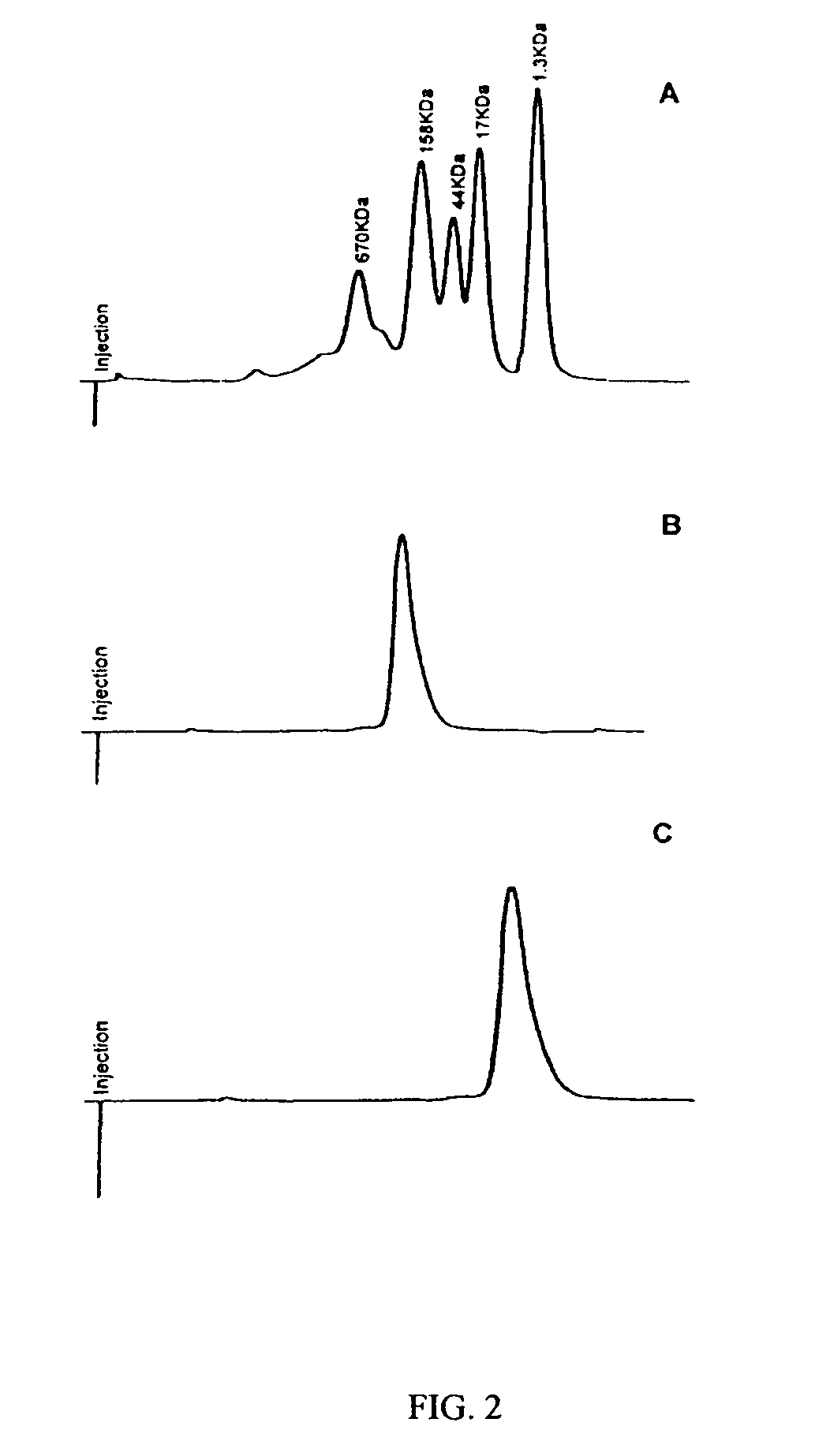Polyalkylene polymer compounds and uses thereof
a polyalkylene glycol and polymer compound technology, applied in the field of polyalkylene glycol compounds, can solve the problems of undesirable side effects during interferon therapy, the use of proteinaceous substances for medical treatment applications, and the difficulty in maintaining or improving the therapeutic benefits of interferon treatment, so as to reduce or eliminate undesirable side effects, limit the therapeutic usefulness of interferon treatment regimes, and maintain or improve the therapeutic benefits of such treatments
- Summary
- Abstract
- Description
- Claims
- Application Information
AI Technical Summary
Benefits of technology
Problems solved by technology
Method used
Image
Examples
example 1
Synthesis of Activated Polyalkylene Glycols
A) Alkylation of Alcohols
[0594]Activated polyalkylene glycols are synthesized by alkylating a polyalkylene glycol having a free terminal hydroxyl functionality. A generic reaction is outlined in Scheme I:
[0595]
[0596]The polyalkylene glycol (P—OH) is reacted with the alkyl halide (A) to form the ether (B). Compound B is then hydroxylated to form the alcohol (C), which is oxidized to the aldehyde (D). In these compounds, n is an integer from zero to five and Z can be a straight- or branched-chain, saturated or unsaturated C1 to C20 alkyl or heteroalkyl group. Z can also be a C3 to C7 saturated or unsaturated cyclic alkyl or cyclic heteroalkyl, a substituted or unsubstituted aryl or heteroaryl group, or a substituted or unsubstituted alkaryl (the alkyl is a C1 to C20 saturated or unsaturated alkyl) or heteroalkaryl group. For substituted compounds, the substituents can be halogen, hydroxyl, carbonyl, carboxylate, ester, formyl, acyl, thiocarbo...
example 2
Preparation of Peptide Conjugates
[0656]The peptide conjugates according to the present invention can be prepared by reacting a protein with an activated PGC molecule. For example, interferon (IFN) can be reacted with a PEG-aldehyde in the presence of a reducing agent (e.g., sodium cyanoborohydride) via reductive alkylation to produce the PEG-protein conjugate, attached via an amine linkage. See, e.g., European Patent 0154316 B1.
[0657]Human IFN-β-1a was PEGylated with the following activated polyalkylene glycols of the invention: 20 kDa mPEG-O-2-methylpropionaldehyde, 20 kDa mPEG-O-p-methylphenyl-O-2-methylpropionaldehyde, 20 kDa mPEG-O-m-methylphenyl-O-2-methylpropionaldehyde, 20 kDa mPEG-O-p-phenylacetaldehyde, 20 kDa mPEG-O-p-phenylpropionaldehyde, and 20 kDa mPEG-O-m-phenylacetaldehyde. The PEGylated proteins were purified to homogeneity from their respective reaction mixtures and subjected to a series of characterization tests to ascertain the identity, purity, and potency of th...
example 3
Specific Activity of PEGylated Human IFN-β-1a in an In Vitro Antiviral Assay
[0688]The specific antiviral activity of PEGylated IFN-β-1a samples was tested on human lung carcinoma cells (A549 cells) that had been exposed to encephalomyocarditis (EMC) virus, and using the metabolic dye 2,3-bis[2-Methoxy-4-nitro-5-sulfo-phenyl]-2H-tetrazolium-5-carboxyanilide (MTT; M-5655, Sigma, St. Louis, Mo.) as a measure of metabolically-active cells remaining after exposure to the virus. Briefly, A549 cells were pretreated for 24 h with either unmodified or PEGylated IFN-β-1a (starting at 66.7 pg / mL and diluting serially 1.5-fold to 0.8 pg / mL) prior to challenge with virus. The cells were then challenged for 2 days with EMC virus at a dilution that resulted in complete cell killing in the absence of IFN. Plates were then developed with MTT. A stock solution of MTT was prepared at 5 mg / mL in PBS and sterile-filtered, and 50 μL of this solution was diluted into cell cultures (100 μL per well). Follo...
PUM
| Property | Measurement | Unit |
|---|---|---|
| molecular weight | aaaaa | aaaaa |
| average molecular weight | aaaaa | aaaaa |
| temperature | aaaaa | aaaaa |
Abstract
Description
Claims
Application Information
 Login to View More
Login to View More - R&D
- Intellectual Property
- Life Sciences
- Materials
- Tech Scout
- Unparalleled Data Quality
- Higher Quality Content
- 60% Fewer Hallucinations
Browse by: Latest US Patents, China's latest patents, Technical Efficacy Thesaurus, Application Domain, Technology Topic, Popular Technical Reports.
© 2025 PatSnap. All rights reserved.Legal|Privacy policy|Modern Slavery Act Transparency Statement|Sitemap|About US| Contact US: help@patsnap.com



